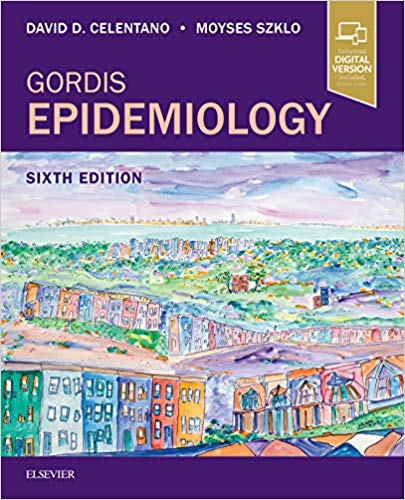Test Bank for Gordis Epidemiology 6th by Celentano
$35.00 Original price was: $35.00.$26.50Current price is: $26.50.
Test Bank for Gordis Epidemiology 6th by Celentano
This is completed downloadable of Test Bank for Gordis Epidemiology 6th by Celentano

Product Details:
- ISBN-10 : 0323552293
- ISBN-13 : 978-0275972165
- Author: David D Celentano ScD MHS (Author), Moyses Szklo MD (Author)
From the Department of Epidemiology at Johns Hopkins University and continuing in the tradition of award-winning educator and epidemiologist Dr. Leon Gordis, comes the fully revised 6th Edition of Gordis Epidemiology. This bestselling text provides a solid introduction to basic epidemiologic principles as well as practical applications in public health and clinical practice, highlighted by real-world examples throughout. New coverage includes expanded information on genetic epidemiology, epidemiology and public policy, and ethical and professional issues in epidemiology, providing a strong basis for understanding the role and importance of epidemiology in today’s data-driven society.
Table of Content:
- Section I The Epidemiologic Approach to Disease and Intervention
- Introduction
- Chapter 1 Introduction
- What Is Epidemiology?
- Objectives of Epidemiology
- Epidemiology and Prevention
- Epidemiology and Clinical Practice
- Epidemiologic Approach
- From Observations to Preventive Actions
- When the Frequency of a Disease Declines, Who Deserves the Credit?
- Integrating Prevention and Treatment
- Conclusion
- References
- Chapter 2 The Dynamics of Disease Transmission
- Modes of Transmission
- Clinical and Subclinical Disease
- Carrier Status
- Endemic, Epidemic, and Pandemic
- Disease Outbreaks
- Immunity and Susceptibility
- Herd Immunity
- Incubation Period
- Attack Rate
- Exploring Occurrence of Disease
- Outbreak Investigation
- Conclusion
- References
- Review Questions for Chapter 2
- Chapter 3 The Occurrence of Disease
- Surveillance
- Stages of Disease in an Individual and in a Population
- Measures of Morbidity
- Conclusion
- References
- Review Questions for Chapter 3
- Chapter 4 The Occurrence of Disease
- Measures of Mortality
- Comparing Mortality in Different Populations
- Other Measures of the Impact of Disease
- Conclusion
- References
- Review Questions for Chapter 4
- Chapter 5 Assessing the Validity and Reliability of Diagnostic and Screening Tests
- Biologic Variation of Human Populations
- Validity of Screening Tests
- Use of Multiple Tests
- Predictive Value of a Test
- Reliability (Repeatability) of Tests
- Relationship Between Validity and Reliability
- Conclusion
- References
- Appendices to Chapter 5
- Review Questions for Chapter 5
- Chapter 6 The Natural History of Disease
- Case-Fatality
- Person-Years
- Five-Year Survival
- Observed Survival
- The Kaplan-Meier Method
- Assumptions Made in Using Life Tables and Kaplan-Meier Method
- Apparent Effects on Prognosis of Improvements in Diagnosis
- Median Survival Time
- Relative Survival
- Generalizability of Survival Data
- Conclusion
- References
- Review Questions for Chapter 6
- Section II Using Epidemiology to Identify the Cause of Disease
- Introduction
- Chapter 7 Observational Studies
- Case Reports and Case Series
- Ecologic Studies
- Cross-Sectional Studies
- Case-Control Studies
- Conclusion
- References
- Review Questions for Chapter 7
- Chapter 8 Cohort Studies
- Design of a Cohort Study
- Selection of Study Populations
- Types of Cohort Studies
- Examples of Cohort Studies
- Cohort Studies for Investigating Childhood Health and Disease
- Potential Biases in Cohort Studies
- When Is a Cohort Study Warranted?
- Case-Control Studies Based Within a Defined Cohort
- Conclusion
- References
- Review Questions for Chapter 8
- Chapter 9 Comparing Cohort and Case-Control Studies
- Chapter 10 Assessing Preventive and Therapeutic Measures
- Selection of Subjects
- Allocating Subjects to Treatment Groups Without Randomization
- Allocating Subjects Using Randomization
- Data Collection on Subjects
- Crossover
- Factorial Design
- Noncompliance
- Conclusion
- References
- Chapter 11 Randomized Trials
- Sample Size
- Recruitment and Retention of Study Participants
- Ways of Expressing the Results of Randomized Trials
- Interpreting the Results of Randomized Trials
- Four Phases in Testing New Drugs in the United States
- Five Major Randomized Trials in the United States
- Randomized Trials for Evaluating Widely Accepted Interventions
- Registration of Clinical Trials
- Ethical Considerations
- Conclusion
- Epilogue
- References
- Review Questions for Chapters 10 and 11
- Chapter 12 Estimating Risk
- Absolute Risk
- How Do We Determine Whether a Certain Disease Is Associated With a Certain Exposure?
- Relative Risk
- Odds Ratio (Relative Odds)
- Conclusion
- References
- Review Questions for Chapter 12
- Appendix to Chapter 12
- Chapter 13 More on Risk
- Attributable Risk
- Comparison of Relative Risk and Attributable Risk
- Conclusion
- References
- Review Questions for Chapter 13
- Appendix to Chapter 13: Levin’s Formula for the Attributable Risk for the Total Population
- Chapter 14 From Association to Causation
- Approaches for Studying Disease Etiology
- Types of Associations
- Types of Causal Relationships
- Evidence for a Causal Relationship
- Guidelines for Judging Whether an Observed Association Is Causal
- Deriving Causal Inferences: Two Examples
- Modifications of the Guidelines for Causal Inferences
- Conclusion
- References
- Review Questions for Chapter 14
- Chapter 15 More on Causal Inference
- Bias
- Confounding
- Interaction
- Conclusion
- References
- Review Questions for Chapter 15
- Chapter 16 Identifying the Roles of Genetic and Environmental Factors in Disease Causation
- Traditional Genetics
- Complex Diseases
- Time Trends in Disease Incidence
- Linkage Analysis in Family Studies
- Interaction Between Genetic and Environmental Risk Factors
- Precision Medicine
- Prospects for the Future
- Conclusion
- References
- Review Questions for Chapter 16
- Glossary of Genetic Terms for Chapter 16
- Section III Applying Epidemiology to Evaluation and Policy
- Introduction
- Chapter 17 Using Epidemiology to Evaluate Health Services
- Studies of Process and Outcome
- Efficacy, Effectiveness, and Efficiency
- Measures of Outcome
- Comparing Epidemiologic Studies of Disease Etiology and Epidemiologic Research Evaluating Effectiveness of Health Services
- Evaluation Using Group Data
- Evaluation Using Individual Data
- Conclusion
- References
- Review Questions for Chapter 17
- Chapter 18 Epidemiologic Approach to Evaluating Screening Programs
- Natural History of Disease
- Pattern of Disease Progression
- Methodologic Issues
- Study Designs for Evaluating Screening: Nonrandomized and Randomized Studies
- Problems in Assessing the Sensitivity and Specificity of Screening Tests
- Interpreting Study Results That Show No Benefit of Screening
- Cost-Benefit Analysis of Screening
- Conclusion
- References
- Review Questions for Chapter 18
- Chapter 19 Epidemiology and Public Policy
- Epidemiology and Prevention
- Population Approaches Versus High-Risk Approaches to Prevention
- Epidemiology and Clinical Medicine: Hormone Replacement Therapy in Postmenopausal Women
- Risk Assessment
- Meta-Analysis
- Publication Bias
- Epidemiology in the Courts
- Sources and Impact of Uncertainty
- Policy Issues Regarding Risk: What Should the Objectives Be?
- Conclusion
- References
- Chapter 20 Ethical and Professional Issues in Epidemiology
- Ethical Issues in Epidemiology
- Investigators’ Obligations to Study Subjects
- Protecting Privacy and Confidentiality
- Access to Data
- Race and Ethnicity in Epidemiologic Studies
- Conflict of Interest
- Interpreting Findings
- Conclusion
- References
- Answers to Review Questions
- Index
People Also Search:
gordis epidemiology
gordis epidemiology 6th by celentano
gordis epidemiology 6th
gordis epidemiology 6th testbank download pdf
gordis epidemiology 6th download scribd
Related products
Test Bank
Test Bank for Operating Systems: Internals and Design Principles, 7th Edition: William Stallings











